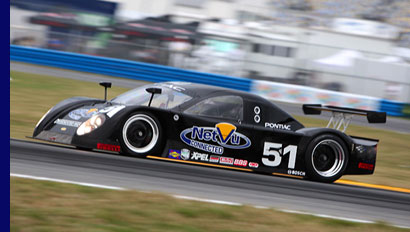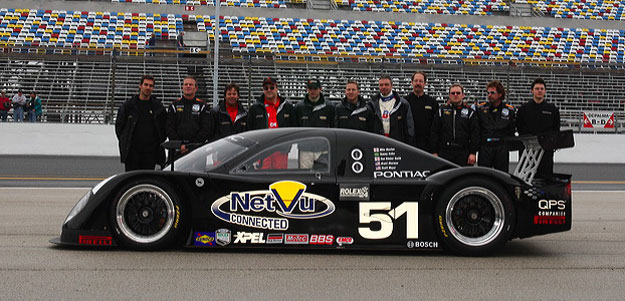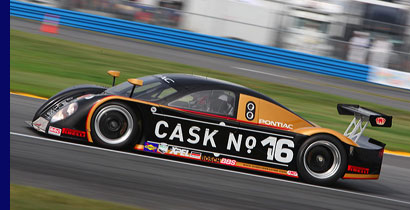RML
AD Group News
RML drivers retire from Daytona 24 Hours
Issued January 29th
2008
Daytona
Disappointment for RML AD Drivers
 It
was a frustrating trip to Florida for Mike Newton and Thomas
Erdos, with hopes of a strong showing in the Rolex 24 Hours
of Daytona coming to a premature and fiery end after just
45 laps.
It
was a frustrating trip to Florida for Mike Newton and Thomas
Erdos, with hopes of a strong showing in the Rolex 24 Hours
of Daytona coming to a premature and fiery end after just
45 laps.
Co-driving the #51 Cheever racing Coyote-Pontiac
with Tom Kimber-Smith, Brent Sherman and Scott Mayer, there
had always been some expectation that the debut for the
Coyote might be eventful, but a genuine “baptism of
fire” had not been among the list of new-car gremlins
the team had expected to face.
Any car, fresh from the factory and with
as many new elements as the Coyote, goes through a stage
of development when minor niggles have to be addressed and
corrected before reliability and performance reach their
optimum. In the case of the #51 Coyote, those trials had
to be exorcised on the track, at Daytona, in full public
view and on a crowded circuit. It was not ideal, but Cheever
Racing, their dedicated crew, and the squad of five drivers
did their best to make things happen, and in many ways,
there are positive elements to be drawn from the experience.
Thomas Erdos, who effectively became the number one driver
in the car, certainly thought so:
“We had a tough time,” he readily
admitted, “but our relationship with Eddie Cheever
is so very good that, despite having such a difficult race,
it is still possible to draw positive conclusions, certainly
from our own point of view.” Neither of the team’s
two cars made it far into the twenty-four hour race, but
while the #16 car lasted a few hours longer than the #51,
it was not a great deal quicker - this despite what appear
on paper to have been advantages. “Ours was a tall
order - to get the car into a position where we could race
it after the initial shakedown in January. We’d had
so little running on the test day earlier in the month (which
had been the car’s first ever run) that we arrived
at Daytona with hardly any mileage on the car at all. That
made the task even greater when we came to preparing for
the race. The car had done so little! We still had so many
other issues to address, that we weren’t in a position
to work on set-up or strategy at all, yet when it came to
qualifying, we ran strongly.”
The sister car had enjoyed a less troubled
test at the start of January and had completed many more
miles of running, so arrived for the race with the prospects
of making full use of all the practice time available. The
#16 squad had also moved ahead to using the new high-specification
Pontiac engine, while the #51 retained the previous and
slightly less powerful unit throughout the pre-race period.
Having to rectify a succession of minor
technical issues meant that practice was seriously curtailed
for the #51 car. Aside from Tommy, who had been chosen to
assist in trying to establish a preliminary set-up for the
car, the other four drivers were unable to benefit from
much track-time in the car. The squad went into qualifying
knowing that there remained a great deal still to do.
As it turned out, Thomas Erdos achieved
a time of 1:43.709 for the 3.56 mile course that, although
sufficient for 22nd overall, was just nine one-hundredths
slower than Matteo Bobbi’s time in the #16. The two
cars would start the race side-by-side on the grid. “Having
had a lot less time to get the car set up, and using the
older-spec engine, to get to within a tenth was great for
us. I think we’d done a good job to make up so much
ground and it was a significant effort,” suggested
Erdos.
Even
so, the first fifteen-minute qualifying session on Thursday
afternoon had not run smoothly, and with a damaged clutch
the day’s evening practice was curtailed, leaving
only time enough for one more short run in the second qualifying
session on Friday. With the first 30 places already set
by the first session, there was no means of improving on
Tommy’s time, but under GrandAm rules, the driver
taking the second session (if the car runs) also has to
start the race. Aside from Tommy, few of the squad’s
other drivers had been able to enjoy much time in the car,
but with Mike Newton one lap short of his required minimum
in order to be qualified to race, it was decided to allow
him the honour of Friday's quarter-hour session. Understandably,
most cars elected to miss it completely, but it did at least
give the CEO of AD Group a further taste of the Coyote.

Raceday
on Saturday saw the Coyote, with Mike Newton at the wheel,
lining up for the 1:30pm start with a brand new, higher-spec
Pontiac engine nestling under the rear cowl. Being twenty-second
out of sixty-eight starters placed the #51 in the first
third of the grid, right in the middle of some of the toughest
jostling, but Mike took the rolling start without a hitch.
“That first stint was just like an extended test,”
said Thomas Erdos. “We were still working on set-up,
and Mike encountered a few fresh problems with the set-up
and braking.” He pressed on nevertheless, and completed
38 laps before pitting after an hour and twelve minutes
to hand over to Thomas Erdos.
After a few tweaks and adjustments, the
Brazilian was swiftly back out on track, and to begin with
the car performed well. Then, as Tommy started the race’s
50th lap, just twenty minutes into his stint, things began
to go seriously wrong. “All of a sudden, as I was
heading out along the front straight, at maximum speed –
nearly 190 mph - the thing just went bang! It was a complete,
catastrophic failure – big time,” he exclaimed.
“There was a fire straight away, although I couldn’t
see it behind me, but I knew what was happening. I pulled
over immediately.”
Tommy was stranded beside the track for
several minutes until two other incidents occurred. The
#40 Hypersport Mazda came to a halt on the apron at Turn
4, and ironically, Antonio Garcia in the sister Cheever
Racing Coyote #16 encountered that car’s first problem.
A full-course yellow was declared while the various cars
were recovered. “When I got back to the garage, there
was a massive hole in the side of the engine,” said
Erdos. “The technicians looked at the data, and it
all looked perfectly healthy until the point that it blew
up. There was absolutely no warning whatsoever.”
 It
was a massive disappointment for everyone, but it would
get worse. Having recovered from the earlier alternator
problem, the #16 would also retire a few hours later after
covering some 170 laps with an overheating engine, possibly
caused by a blockage to the radiator intakes. Although not
a great weekend for the team, it had still been an enjoyable
one for AD Group and the American guests who had watched
the spectacle of the Daytona 24 Hours unfold. “That
we didn’t finish was certainly a disappointment for
them,” suggested Tommy, “but on the plus side,
it did mean that Mike and I could spend more time with them
in the suite. Many of them watch the end of the race with
us, and it was great to experience their support and enthusiasm.
Even with all the problems, I thoroughly enjoyed working
with Eddie and the team. It may have been a bit frustrating
at times, but the atmosphere remained so good throughout.”
It
was a massive disappointment for everyone, but it would
get worse. Having recovered from the earlier alternator
problem, the #16 would also retire a few hours later after
covering some 170 laps with an overheating engine, possibly
caused by a blockage to the radiator intakes. Although not
a great weekend for the team, it had still been an enjoyable
one for AD Group and the American guests who had watched
the spectacle of the Daytona 24 Hours unfold. “That
we didn’t finish was certainly a disappointment for
them,” suggested Tommy, “but on the plus side,
it did mean that Mike and I could spend more time with them
in the suite. Many of them watch the end of the race with
us, and it was great to experience their support and enthusiasm.
Even with all the problems, I thoroughly enjoyed working
with Eddie and the team. It may have been a bit frustrating
at times, but the atmosphere remained so good throughout.”
The
eventual winners were Chip Ganassi Racing (with Felix Sabates),
who became the first team to capture three straight Rolex
24 wins, with victory going to the #1 Target Lexus Riley
driven by Scott Pruett, Memo Rojas, Juan Pablo Montoya and
Dario Franchitti.
Now Mike and Tommy can look ahead to their
Le Mans Series season, which kicks off with two shakedown
tests in the UK in February ahead of the first official
test at Paul Ricard at the start of March.
Further
information from CheeverRacing.com
All
photos courtesy of www.daytona24hr.com
